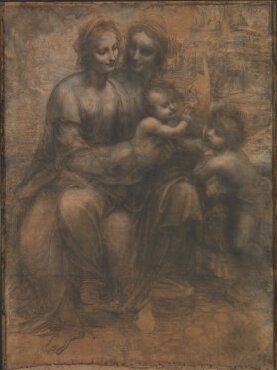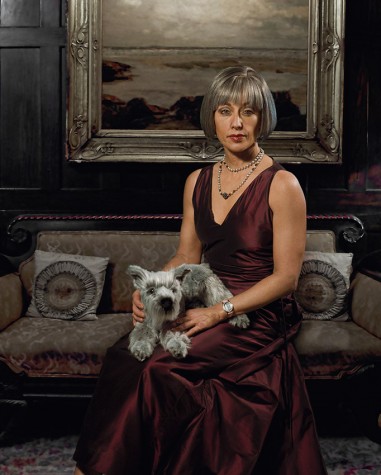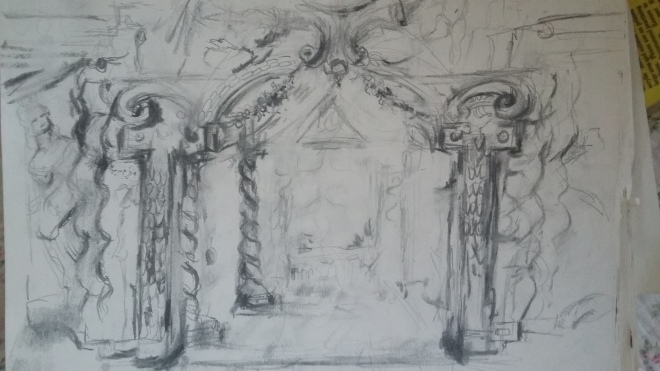A post that shows us the most influential artwork you have seen first hand either on a London trip or in a gallery in Cardiff, with a brief description of how it has influenced your practice..
The Burlington house Cartoon – The Virgin and Child with Saint Anne and the Infant Saint John the Baptist, In the national portrait gallery in London by the great Leo Da Vinci.
I have visited this gallery before, on probably each occasion of going to London. The building is so big, and normally really busy, that it has taken a few visits for me to see every piece of work in the gallery.
The last time we went to London for the uni trip, I found the space/room where this painting is placed. What I loved about this especially was how it was exhibited, in a dark room – there was purposeful artificial lighting that gave another dimension to the painting/for the viewer.
I felt that it gave the painting a realistic approach, however mysteriousness came out through the transparency of the charcoal in contrast to the brown canvas. The piece seems and gives the impression that it is valuable and precious like gold, as of it’s installation of lights in a dark room, that makes it stand out from the other pieces.
The bodies are intertwined with one another, as the baby sits upon both women’s laps, where it is puzzling to indicate which set of legs matches to each torso. The arms of the woman at the front are missing, and blends in with the baby’s body. This also makes the prep drawing (for a later painting) (nationalgallery.org.uk) muddled and scatty, that for me makes a piece of work stand out because it brings curiosity and creepiness.
My silk paintings can relate to this piece because of it’s transparency, even as a total different 
The exhibitions at the Royal academy were insightful and thought-provoking too, such as Ai Wei Wei’s installations in December that were personal outcomes from his time in prison, when he was looked over 24 hours a day, even when showering and going to the toilet.
I liked the way this was interactive, and felt really real compared to a painting or 2D piece.
Therefore has influenced my future decisions/ideas of how installations and 3D pieces can have huge benefits to a piece of work.
 This photo by Sherman is from her 2008 collection; about status and this generation’s increase on this ‘status-obsessed’ culture.
This photo by Sherman is from her 2008 collection; about status and this generation’s increase on this ‘status-obsessed’ culture. This painting stood out to me at first because of the movement it creates – as if I am watching a theatre play as a narrative; the elegant posture of the four main figures at the front go in a diagonal line where the eye captures the detailed stair case and the lions – dramatic and exaggerated. I am also intrigued by the costumes and the environment this painting shows – the robes and long-tail dresses in an exotic sense. The audio description about this painting is on the NSW art gallery website, helping me to understand more about the context of the painting/story:
This painting stood out to me at first because of the movement it creates – as if I am watching a theatre play as a narrative; the elegant posture of the four main figures at the front go in a diagonal line where the eye captures the detailed stair case and the lions – dramatic and exaggerated. I am also intrigued by the costumes and the environment this painting shows – the robes and long-tail dresses in an exotic sense. The audio description about this painting is on the NSW art gallery website, helping me to understand more about the context of the painting/story:


 mall flowers, some thin branches in the right and maybe some stones and rocks to the back-near the horizon. Again, he creates a textured feel to it.
mall flowers, some thin branches in the right and maybe some stones and rocks to the back-near the horizon. Again, he creates a textured feel to it.